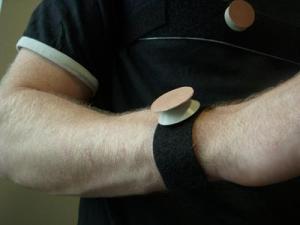by: Jason Mick

In an age in which wireless transmitters are invading every aspect of our lives, the human body is no exception. From RFID implants to wireless equipped pacemakers, scientists are looking to leverage the power of wireless communication to combat disease and aid in identification.
When it comes to medical implants, people often have more than one. If these implants could communicate, they could work together more optimally and watch for trouble. Further, they could better communicate with computers or other control and monitoring devices. However, in order to communicate wirelessly you need a good antenna.
Various designs have been tried with little success. Compact patch antennas, which adhere to the skin are compact, but offer a week signal as most of the transmission is directed out, away from the body. Mast style antennas similar to those in cars work better, but they are both bulky and they too lose a fair amount of signal to outward transmission.
Now researchers at the Queen's University Belfast, Northern Ireland have developed a better alternative. Scientists William Scanlon and Gareth Conway hatched the new design, which resembles a hockey puck. It channels signals along the skin to reach devices anywhere in the body. The device is much more power efficient than power hoarders like Bluetooth, which is a definite necessity for the field of medical implants, which rely on long battery lives.
The new antenna exploits the physical phenomenon known as the "creeping wave effect". This effect involves waves traveling along the surface of the skin, and is how you can hear a sound in both ears that appears directly next to one side of your head.
Traditional monopole antennas involve a long pole standing on a plate of conductive material (such as a car roof). The plate reflects signals traveling downward. By turning the plate upside down, researchers discovered they could do the opposite -- reflect signals traveling upward back along the skin. Scanlon states, "There is a mismatch between the air and the body tissue, which causes a reflection of sorts."
According to Scanlon, the channeling is the key to the device's energy efficiency. The end result is battery life of body-worn devices could be doubled, he says.
John Batchelor, a researcher at the University of Kent who is working on similar devices, praised the work. He says, "The idea of inverting the antenna to encourage surface wave propagation around the body is worth patenting."
And he predicted correctly -- Scanlon and Conway have applied for a patent for the work. Hopefully their research will soon be helping to further the field of medical implants and monitoring devices.
